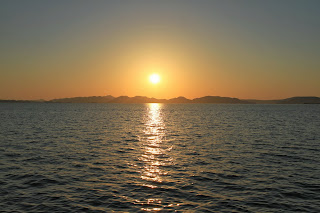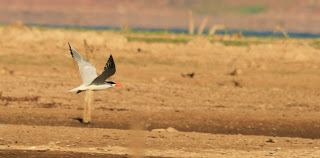Today was the day of the Yellow Chat boat-cruise on Lake Argyle! We arrived at the boat ramp at Lake Argyle by 5.20am. We had 5 companions for the day, taking the total number of people to 8. The others were Mike Fidler, Ian Campton, Kay and Neil and Case, and they arrived a couple of minutes later.
We were installed on the boat, the skipper Greg gave us a brief rundown of how the day would run, and we were off.
I
was expecting your ordinary 'putt-putt' tourist boat, but this thing
absolutely flew! We were speeding over the
glassy, jade-green waters of the lake, and the wind was refreshing even
in the relatively cool, 15-degree morning.
Lake
argyle is approximately 70km long, the biggest man-made lake in Australia. We enjoyed a stunning
sunrise as we were sailing out to our first stop - a small bay, to enjoy
the scenery and birdlife along the lake shore with our catered
breakfast.
Magpie-goose flyover
The
stop put us directly in front of the gigantic stick nest of a White-bellied Sea-eagle pair, and we could just see the head of one bird
peeking out from the top. There were Long-tailed Finches nesting in gaps
in the sticks of the nest, giving me an excellent opportunity to have a look at something I'd wanted to see since I read
about it in the Morcombe field guide when I was 5 - small prey species
seeking protection in the nest of large predators.
WBSE Nest
Aaaand here's Mum....
Forest of dead trees at the breakfast stop
I
can tell you, I got the impression during breakfast (and it was an
impression that was furthered throughout the trip), the $120 the eight of
us paid to be on that boat may seem like a lot, but they could easily
charge far, far more for the service you get. Breakfast was brilliant, and Greg was very knowledgeable about the Lake
and it's avian inhabitants, as well as it's less-feathered clientele.
At
that stop we picked up several species, including a few new ones for me
such as Wandering Whistling-duck, Pied Heron, and Glossy Ibis. White-breasted Woodswallows hawked close to the boat, and I picked up a Wood
Sandpiper feeding among the abundant subadult Comb-crested Jacanas at
the water's edge.
Australian Pelican
We got back underway and
headed for the trip's main stop - Yellow Chat Island, home to the (not
at all obvious from the name) Yellow Chat. This is the species we were
targeting for the day, and, as far as I know, it's supposed to be the easiest place to
get this species in Australia. It took us some time and several species
to get there. We saw the first and only Freshwater Crocodile of the ride
on the way, and we eventually arrived about 8am.
Freshwater Crocodile
Caspian Tern on arrival at Yellow Chat Island
The
day was already stinking hot, so the short wade ashore was quite nice -
until the actual coming ashore bit. I was wearing boots, and I had to
take them off to get in the water. Quick tip, if you're doing this boat
ride, take thongs, or shoes that you can completely submerge in water and then
immediately walk around in!! Unless you like walking around on sticky
mud and several centimetres of accumulated bird dung.
Once
ashore, we could look around the island. As a place to be, it is
incredibly barren - mud, rocks, some tall dead grassy plants - nothing
abut the place is hospitable. It's a very large island, and we would
have covered a little more than half in the two hours or so we were
ashore, but it doesn't get much greener than first sight.
We
were all ashore, and almost immediately I had the pleasure of being the
first to call "Yellow Chat!". An adult male was flicking about in the
tall dead grasses directly in front of us, providing nice views and some
photo opportunities. I thought that would be that, but no - there was
better to come.
Australian
Pratincoles were abundant on the island, and the lowest water level in
several years saw the island's fringes become a vast, muddy wetland,
supporting several thousand Magpie Geese, phenomenal numbers of Hardhead
and other ducks, and up to a hundred Green Pygmy-geese. these birds
were impossible to approach, but provided stunning
viewing as they took off in vast, intertwining flocks.
Plumed Whistling-duck, Magpie Goose and Black-winged Stilt
Making
our way round the western edge of the island (having entered from the
north), we quickly caught up with more Chats, including females this
time. During our time on the island, I would say we saw at the very
least 15, probably more like 20 individuals at close range. Mike Fidler
wandered off on his own to try and get better pictures with his 300mm f2.8 +
2xTC combination.
Whiskered Tern
As
I said, we spent two awesome hours on the island, mainly stalking the
chats. On our way back to the boat, we saw 7 Australian Bustard in the
distance, a nice addition to the trip list.
We
collected Mike, and set off again, this time on a lap of the island. At
that point it was close to 10.00am, and boiling in the sun, so the
watermelon and cold drinks on board were pretty much lifesavers. As we
circled the island, we powered through enormous, thousand-strong flocks
of Hardhead, Magpie Geese and Pacific Black-duck, and stopped briefly to
observe Nankeen Night-heron and Great-crested Grebe before continuing.
To
my delight, as we were almost all the way round the island, we ran into
a huge flock (1000+) of Green Pygmy-geese, which are now one of my
favourite small swimming birds.
As
we departed the island and got up to speed, a Great-crested Grebe
surfaced and ran alongside us, keeping pace with the boat, for several
meters before diving again, giving us a great view.
On
the return journey now, we passed the rock faces and saw a species of Rock Wallaby (which I'm not sure the exact identity of) hiding in the caves and crevices.
We
stopped for a while at two different areas of rock face and played the
call of the Sandstone Shrike-thrush, a species Ashwin had told me was
very difficult, so I wasn't expecting much. We dipped at the first site,
but at the second, a single bird hopped onto a rock into plain view -
everyone's view except mine, apparently. It took Mike a good five
minutes to help me find it, and even after that the bird sat obligingly
halfway up the cliff before flying off. Greg observed that that was the
first time he had ever seen a silent one, and that previously he had
always heard it before seeing it.
A
final stop brought us within just a few meters of a party of White-quilled Rock Pigeon, a brown but nonetheless beautiful bird.
As
a conclusion on the boat trip - DO IT IF YOU CAN!! The birding is
fantastic, the scenery is breathtaking and provides completely new views
of the lake and cliffs unobtainable any other way, the guides are
knowledgeable, friendly, and the whole affair is great fun!
We got underway, destination Wyndham, and more specifically, Parry's Creek
Farm, a tourist resort just out of town. This would be the
main headquarters for the Gouldian count.
We
stopped for a while on the way, at a small waterhole by the roadside
that Derek remembered from last year as a good spot to see Pictorella
Mannikin. It was about 2pm, and no Pictorellas came in, but even in the
heat of the afternoon we had a lot of activity with plenty of
opportunity for photos (if perhaps not at eye level). We earmarked the
spot for the next morning and moved on.
Zebras and a Long-tailed Finch, with a sneaky Weebill
Rufous-throated Honeyeaters and a Peaceful Dove
Diamond Dove
Masked and Long-tailed Finches
We
arrived at Parry's Creek, and I have to say, it wasnt quite what I
expected. Dust reigned, the calling card of a long dry season. I was
expecting grass and leafy trees, as I'd seen in the campgrounds along
the way. The advertising screen in the office told me it usually is
exactly that, but not so now. We set up camp in a small area of shade
in the sahara-reminiscent dust field.
After
that, we pretty much just relaxed! Case, Ian, Neil and Kay were staying
at Parry's too, so we all hung around in the shade until the sun went down.
1st September
This
morning early, before light, we were on the road headed back to
yesterday's waterhole. A brilliant mornings birding produced no less
than FIFTY-SEVEN Gouldian Finches by Mikes count, including several full coloured
adults, providing very nice photo ops.
Lots of other birds too, mainly honeyeaters and heaps of finches. No pictorellas.
After
that, Mike showed us a spot called Pumpkin Spring, just off the road a
few km back from the waterhole. Pulling up, we saw a Pheasant Coucal
flying off, and in the dense stand of pandanus around the spring,
Crimson Finches, Double-bars and even a few late rising Gouldians were
seen drinking from the puddles in the cow hoof prints in the soft mud.
We
drove into Kunnunurra to 'The Hoochery', as it is known, a large area of crop seeds known as a site for the Yellow-rumped Mannikin. No luck, but we did hear Red-backed Fairy Wren among
the sorghum stems. Not a lifer or even a year tick, but a trip tick and a
very nice bird nonetheless.
Golden-headed Cisticola
We
returned to Parry's Creek, stopping at a small roadside waterhole in the
way. A pair of Brolgas strolled off, and a pair of nesting Brown Falcons above the waterhole gave me doubts we'd see anything good. I was
right, nothing interesting came in.
Brolga
We
relaxed in camp for a while, then took a drive the Marlgu Lagoon, part
of the RAMSAR wetland within which Parry's Creek Farm is situated. Many
birds, but apparently down on last year. Nothing new for me except I got
photos of Australian Pipit.
Driving
out though, we pulled over to check out some larks (which turned out to
be Horsfields Bushlark - tick!) and found a couple of Star Finches
mixed into a flock of Zebras and Double Bars. Double tick!
Horsfields Bushlark
We went swimming in the pool until it was almost time for the opening meeting of the count at 5pm.
Mike
Fidler and Sarah Pryke did the opening presentations on the count and how it functions, which was very interesting.
I'm
now sitting in my swag, itching mozzie bites and wiping dust off
everything, and almost falling asleep. Hopefully some good stuff to
report tomorrow for the first day of the count!!









































No comments:
Post a Comment